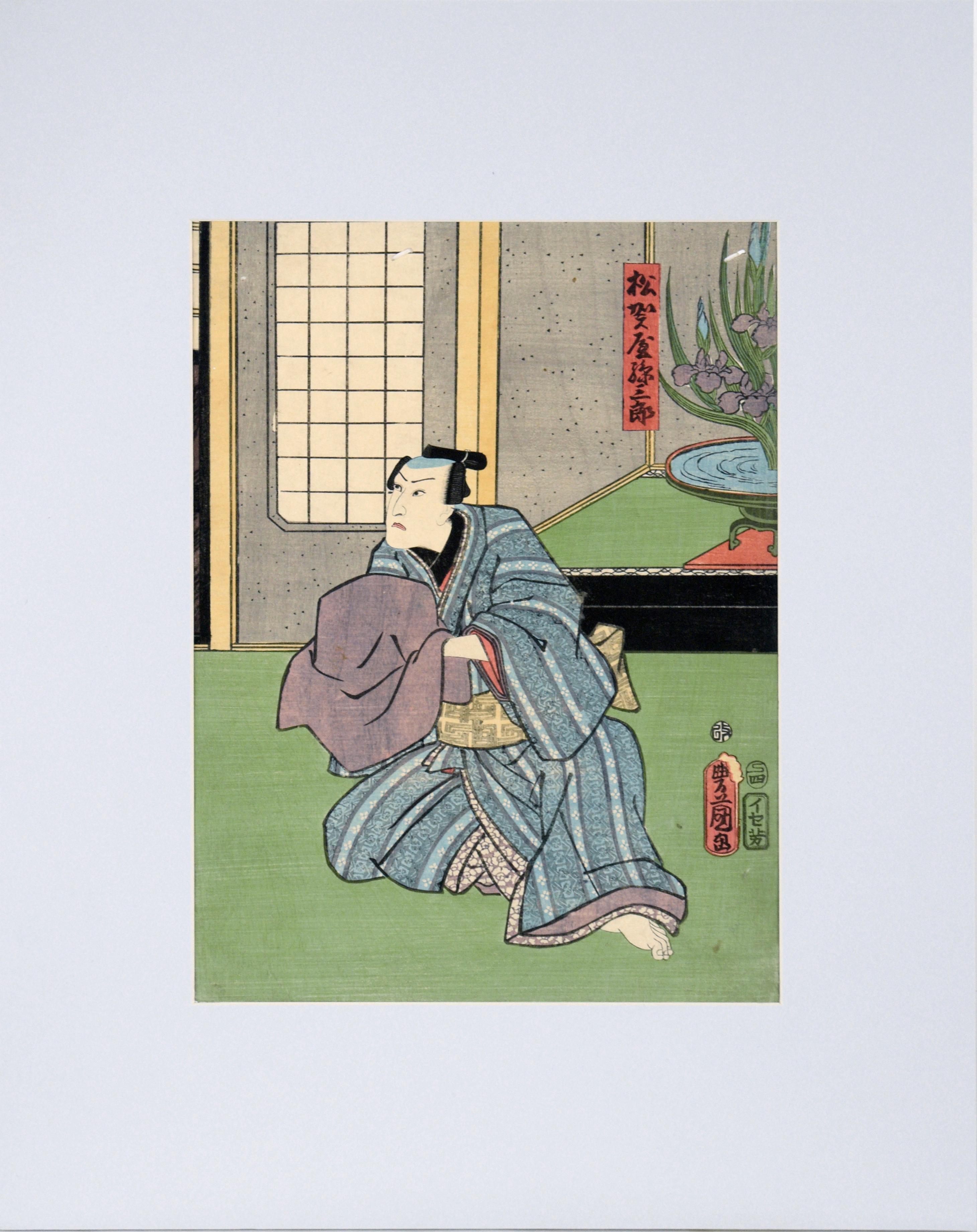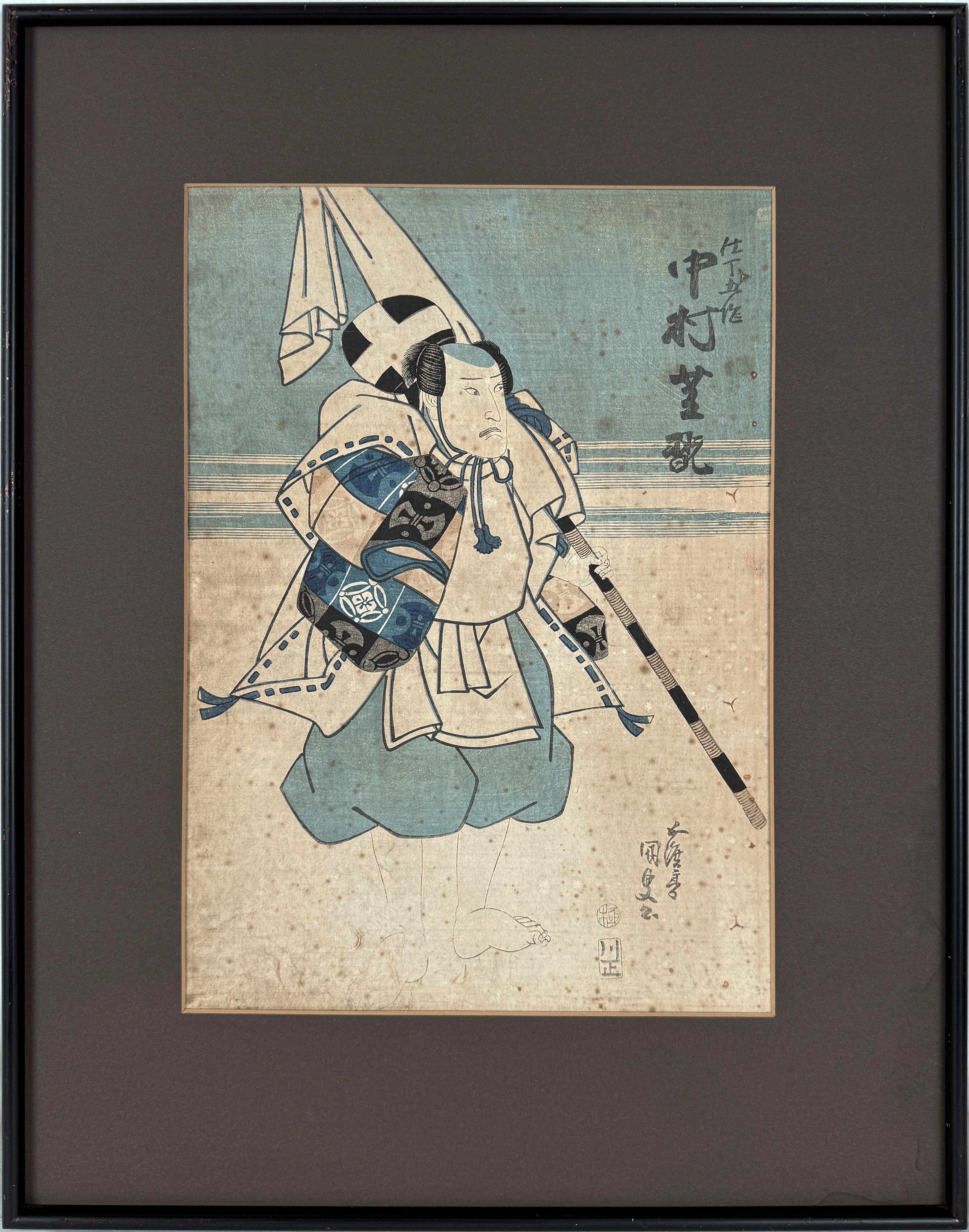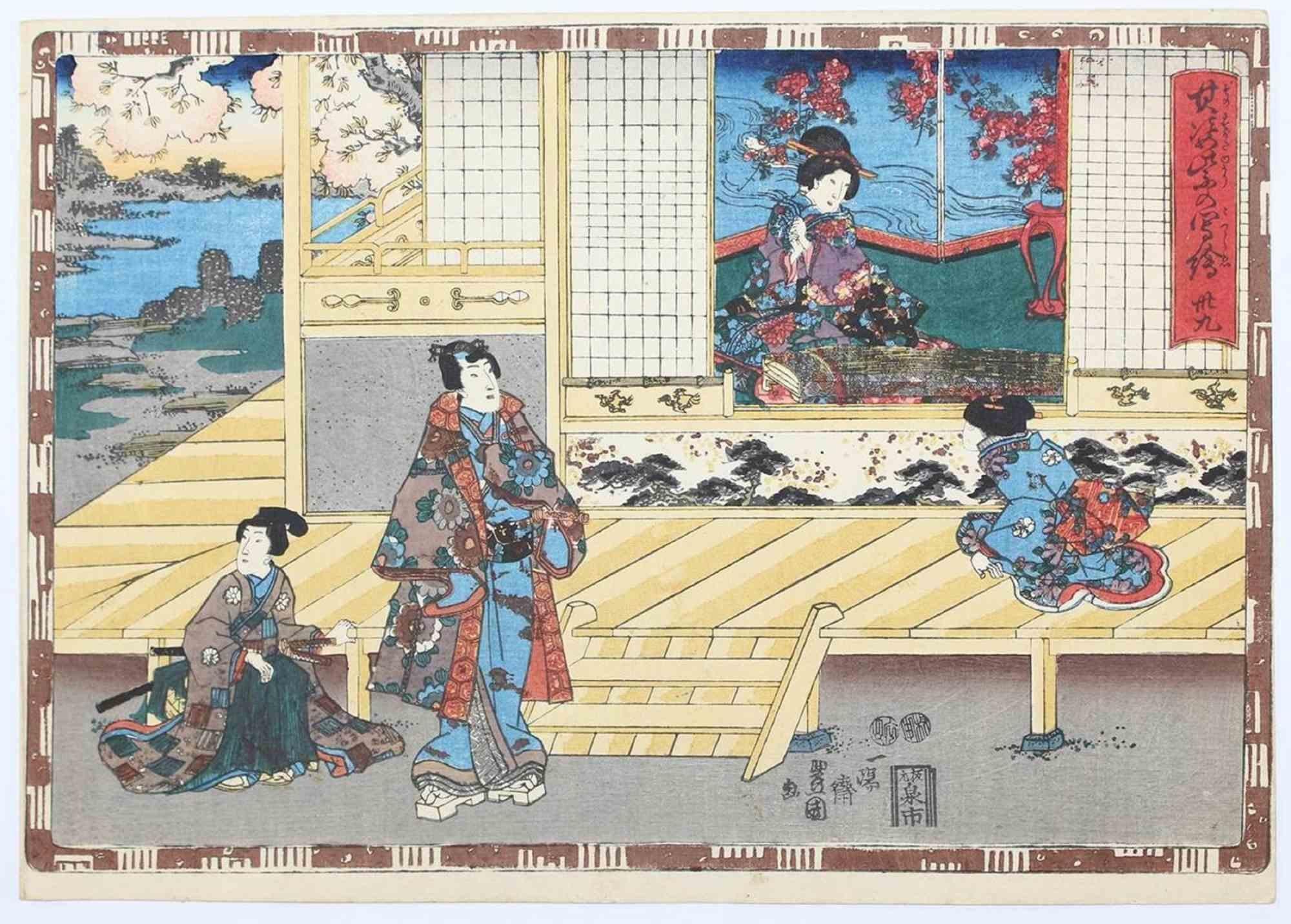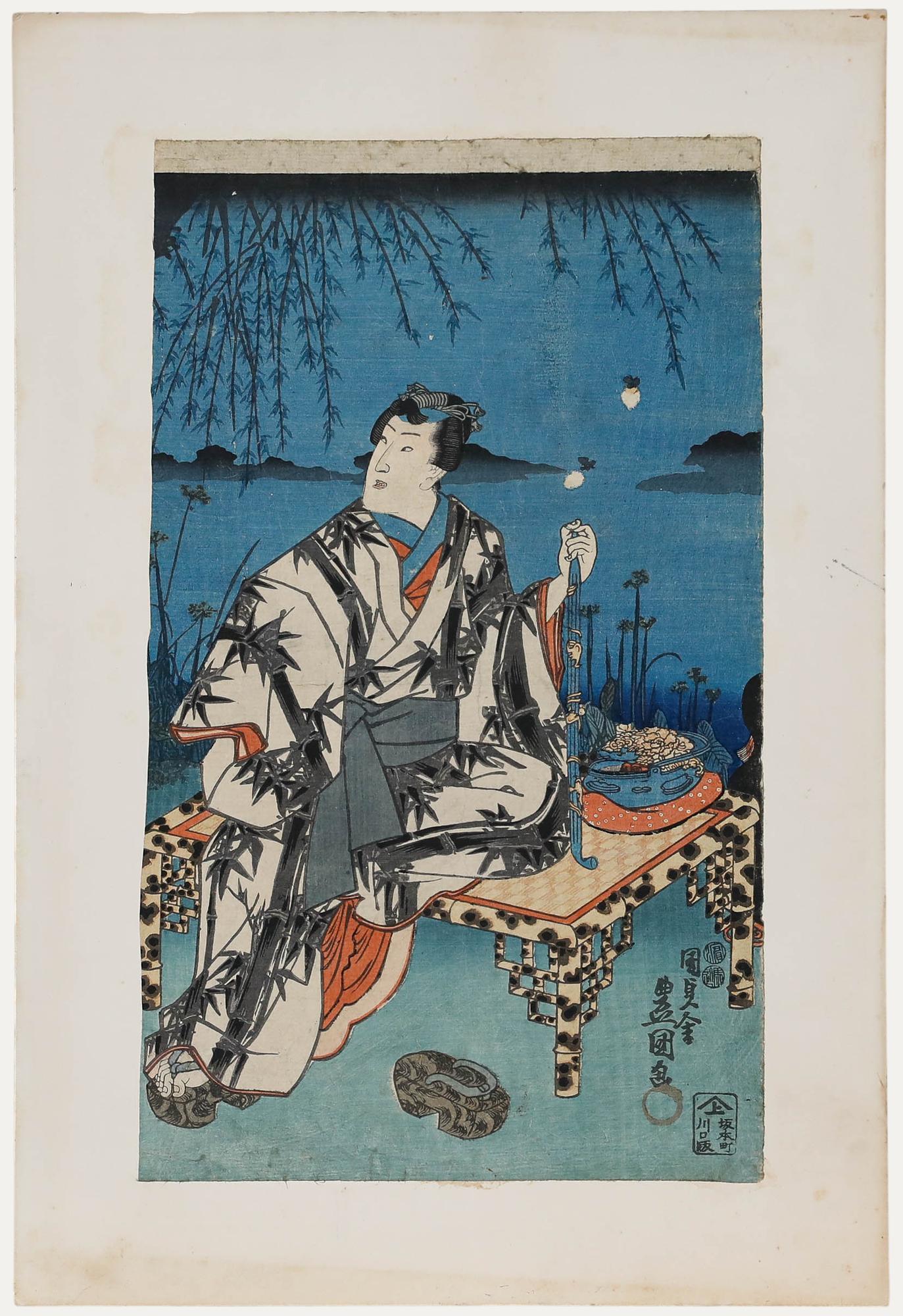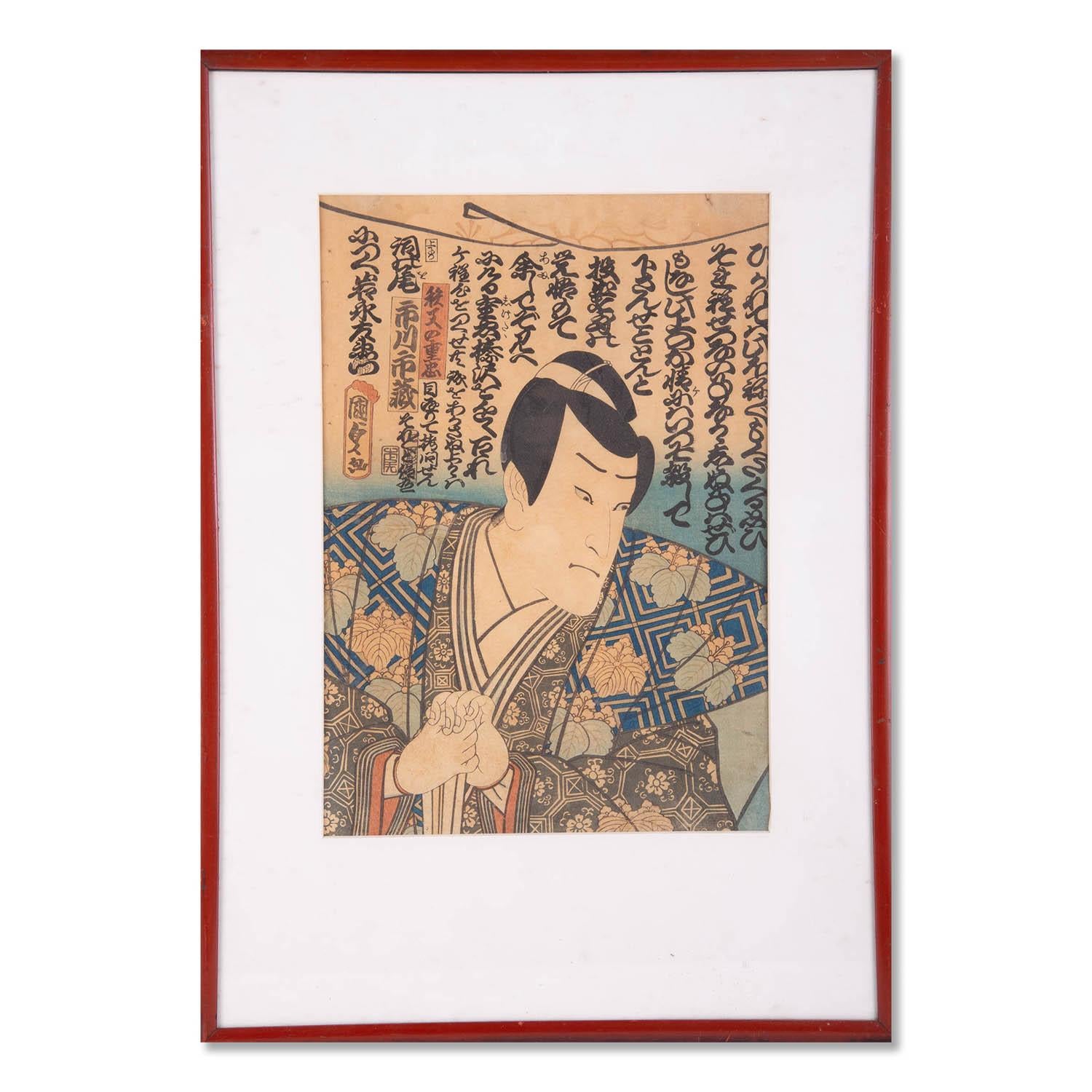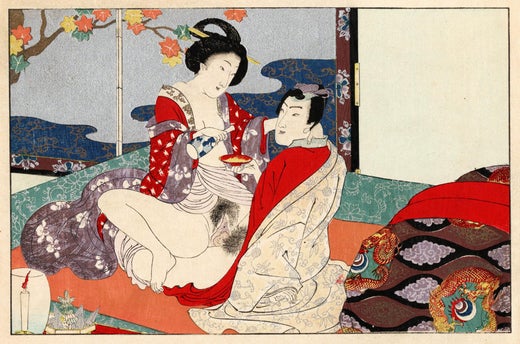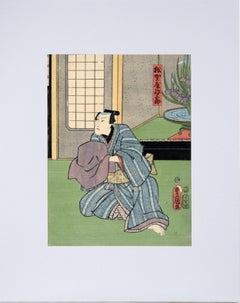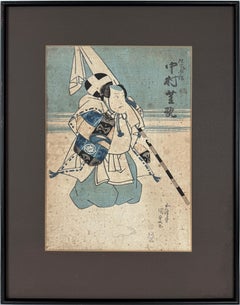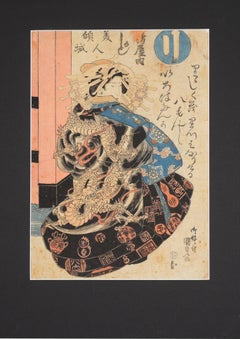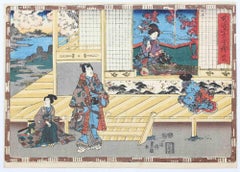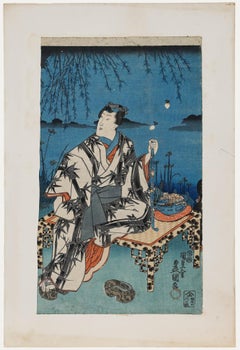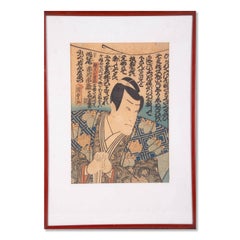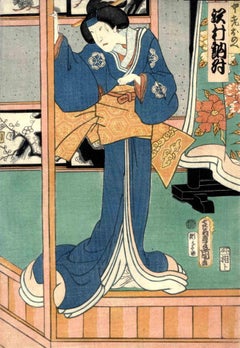Items Similar to "Juro Sukenari, Station #9: Oiso", Mid 19th Century Japanese Ukiyo-e Woodblock
Want more images or videos?
Request additional images or videos from the seller
1 of 13
Utagawa Kunisada (Toyokuni III)"Juro Sukenari, Station #9: Oiso", Mid 19th Century Japanese Ukiyo-e Woodblock1852
1852
$460
$57520% Off
£347.43
£434.2820% Off
€401.52
€501.9020% Off
CA$645.22
CA$806.5320% Off
A$717.55
A$896.9320% Off
CHF 375.60
CHF 469.5020% Off
MX$8,753.21
MX$10,941.5120% Off
NOK 4,719.59
NOK 5,899.4920% Off
SEK 4,439.38
SEK 5,549.2320% Off
DKK 2,997.11
DKK 3,746.3920% Off
About the Item
Beautiful mid 19th century Japanese woodblock print of a samurai by Utagawa Toyokuni III (Kunisada) (Japanese, 1786-1864/5). This piece is from a series of "The 53 Stations of the Tokaido" and was originally a diptych. It depicts the actor Ichimura Uzaemon XII in the role of Juro Sukenari, in the play Soga Mono. Artist's chop is on the right edge of the piece. Presented in a cream mat, with a black and red frame and plexiglas. Image size ~14.5"H x 10.5"W
During his lifetime Kunisada Utagawa was considered to be the best print designer by his contemporaries. He was more popular than Hiroshige, Hokusai or Kuniyoshi. And Kunisada was extremely productive. His total output is estimated at more than 20,000 designs, many made by his students.
Kunisada was born near Edo (today Tokyo) as the son of an affluent merchant with a ferry boat license. At the age of fifteen he joined the famous art school of Utagawa Toyokuni and took the name Kunisada.
In 1807 the young artist produced his first illustrated book. And in 1808 his first actor prints were published. His fame grew fast. While other artists like Kuniyoshi Utagawa or Hiroshige had to fight for recognition for years, he was successful from the beginning.
He should become the most commercially successful of all woodblock printmakers ever. His early success may not have had a good influence on his personality. He had a reputation for his conceited personality.
Kunisada designed a wide spectrum of traditional ukiyo-e subjects like kabuki themes, beautiful women, historical events and quite a few shunga prints. He made few landscapes.
- Creator:Utagawa Kunisada (Toyokuni III) (1786-1864, Japanese)
- Creation Year:1852
- Dimensions:Height: 21.63 in (54.95 cm)Width: 17 in (43.18 cm)Depth: 1 in (2.54 cm)
- Medium:
- Movement & Style:
- Period:
- Condition:Tonal ageing to paper, as expected for a piece of this age. Otherwise in very good condition. Damage to frame (repaired). Minor scratches on plexiglas.
- Gallery Location:Soquel, CA
- Reference Number:Seller: JT-DBH65521stDibs: LU5428410072
Utagawa Kunisada (Toyokuni III)
Born in the Honjo district of Edo as Kunisada Tsunoda, Kunisada’s family owned a small hereditary ferryboat service. Though his father, an amateur poet, died when Kunisada was a child, the family business provided some financial security. During his childhood, he showed considerable promise in painting and drawing. Due to strong familial ties with literary and theatrical circles, he spent time studying actor portraits. At age 14, he was admitted to study under Toyokuni, head of the Utagawa school. Kunisada's work embodies the characteristics of the Utagawa school, focusing on traditional subjects such as kabuki, bijin (beautiful women), shunga (erotic prints), and historical prints. His first known print dates to 1807, his first illustrated book to 1808. Kunisada’s career took off from the beginning. Many of his works became overnight successes and he was considered the “star attraction†of the Utagawa school. He signed his works “Kunisada,†sometimes with the studio names of Gototei and Kochoro affixed. In 1844, he adopted the name of his teacher and became Toyokuni III. Kunisada passed away in 1864 in the same neighborhood that he was born. He was 70 years old. Kunis
About the Seller
5.0
Platinum Seller
Premium sellers with a 4.7+ rating and 24-hour response times
Established in 1986
1stDibs seller since 2014
2,984 sales on 1stDibs
Typical response time: <1 hour
- ShippingRetrieving quote...Shipping from: Soquel, CA
- Return Policy
Authenticity Guarantee
In the unlikely event there’s an issue with an item’s authenticity, contact us within 1 year for a full refund. DetailsMoney-Back Guarantee
If your item is not as described, is damaged in transit, or does not arrive, contact us within 7 days for a full refund. Details24-Hour Cancellation
You have a 24-hour grace period in which to reconsider your purchase, with no questions asked.Vetted Professional Sellers
Our world-class sellers must adhere to strict standards for service and quality, maintaining the integrity of our listings.Price-Match Guarantee
If you find that a seller listed the same item for a lower price elsewhere, we’ll match it.Trusted Global Delivery
Our best-in-class carrier network provides specialized shipping options worldwide, including custom delivery.More From This Seller
View All"Sun Saburo Matsugaya" - Mid 19th Century Figurative Japanese Woodblock Print
By Utagawa Kunisada (Toyokuni III)
Located in Soquel, CA
"Sun Saburo Matsugaya" - Mid 19th Century Figurative Japanese Woodblock Print
Beautiful mid 19th century figural Japanese woodblock print of a seated man with lilies in the background by Utagawa Toyokuni III (Kunisada) (Japanese, 1786-1864/5). Artist's chop is in the lower right corner of the piece. The actor is Magosaburo Matsugaya from the play "Katakiuchi Rumors"
Presented in a new grey-blue mat with foamcore backing.
Mat size: 21"H x 16"W
Paper size: 14"H x 9.75"W
During his lifetime Kunisada Utagawa...
Category
1850s Edo Figurative Prints
Materials
Paper, Ink, Woodcut
Kabuki actor Nakamura Shikan II by Utagawa Kunisada Edo Japanese Woodblock Print
By Utagawa Kunisada (Toyokuni III)
Located in Soquel, CA
Kabuki actor Nakamura Shikan II by Utagawa Kunisada Japanese Woodblock Print
Wonderful portrait of Nakamura Shikan II, a prominent kabuki actor, in the role of Kisen Hoshi Toyokuni ...
Category
1820s Realist Figurative Prints
Materials
Printer's Ink, Rice Paper, Woodcut
Kabuki Actor, Mid 19th Century Figurative Japanese Woodblock Print
By Utagawa Kunisada (Toyokuni III)
Located in Soquel, CA
Beautiful mid 19th century figural Japanese woodblock print of a kabuki actor in blue by Utagawa Toyokuni III (Kunisada) (Japanese, 1786-1864/5). Artist's chop is in the upper left corner of the piece. Presented in a cream mat, with a black and red frame and plexiglas. Image size ~13.5"H x 9.5"W
During his lifetime Kunisada Utagawa...
Category
1860s Edo Figurative Prints
Materials
Paper, Ink
The Courtesan Kashiwagi and the Kamuro Wakano - Japanese Woodblock Print
By Utagawa Kunisada (Toyokuni III)
Located in Soquel, CA
The Courtesan Kashiwagi and the Kamuro Wakano - Japanese Woodblock Print
Original Toyokuni III/Kunisada (Japanese, 1786 - 1864) Japanese Woodblock Print
"The Courtesan Kashiwagi and...
Category
1820s Realist Figurative Prints
Materials
Printer's Ink, Rice Paper, Woodcut
Kumasaka Chōhan to Ushiwakamaru - One of a Diptych Original Woodcut Print
By Utagawa Kunisada (Toyokuni III)
Located in Soquel, CA
Kumasaka Chōhan to Ushiwakamaru is a Japanese Ukiyo-e print created between 1848 and 1854 by artist Utagawa Kunisada (Japanese, 1786-1864). The print is a Diptych, and is part of the...
Category
1850s Realist Figurative Prints
Materials
Printer's Ink, Rice Paper, Woodcut
Ichimura Uzaemon XIII - actor as Okaji of Gion, 1862 "The Six Poetry Immortals"
By Utagawa Kunisada (Toyokuni III)
Located in Soquel, CA
Ichimura Uzaemon XIII - actor as Okaji of Gion, 1862 "The Six Poetry Immortals"
A Japanese Ukiyo-e woodcut print created circa 1862 by artist Utagawa Kunisada (Japanese, 1786-1864). ...
Category
1850s Realist Figurative Prints
Materials
Printer's Ink, Rice Paper, Woodcut
You May Also Like
Yugiri - Woodcut by Utagawa Kunisada - 1850s
By Utagawa Kunisada (Toyokuni III)
Located in Roma, IT
Yugiri is an original artwork realized in the 1850s by Utagawa Kunisada (1786-1865).
Chapter 39 of the story Genji Monogatari. Color woodcut around 1851. Signed: Ichiyossai Toyokun...
Category
1850s Modern Figurative Prints
Materials
Woodcut
Utagawa Kunisada (1786-1865) - Mid 19th Century Japanese Woodblock, Niwa Suzumi
By Utagawa Kunisada III
Located in Corsham, GB
The central print from a triptych by the prolific ukiyo-e artist Utagawa Kunisada titled *Niwa Suzumi* (Cooling Off in the Garden). Signed within the print to the lower right. On Jap...
Category
Mid-19th Century Portrait Prints
Materials
Woodcut
Utagawa Kunisada III (1848-1920) Ukiyo-E Woodblock Print "Portrait Of Samurai"
By Utagawa Kunisada III
Located in New York, NY
Title: Portrait Of Samurai
Medium: Woodblock Print
Style: Ukiyo-e
Size: 13 1/2"" x 9 1/2""
Frame Size: 18 1/2"" x 14 1/2""
Signature: Kunisada
Provenance: Collection from E...
Category
Early 20th Century Other Art Style Portrait Prints
Materials
Washi Paper, Woodcut
Sawamura Tosho - Woodcut Print by Utagawa Kunisada - 1862
Located in Roma, IT
Sawamura Tosho is an original modern artwork realized by Utagawa Kunisada in 1862.
Woodcut print Oban from a tryptich
Signature Kio Toyokuni ga (77 Toyokuni). Publisher: Soshuya. ...
Category
19th Century Modern Figurative Prints
Materials
Woodcut
Kabukie - Woodcut by Utagawa Kunisada - 1850s
Located in Roma, IT
Kabukie is an original artwork realized in the 1850s by Utagawa Kunisada (1786-1865).
Oban from a triptych.
An actor in the role of Otokodate Abe no Homei stands ready at night in...
Category
1850s Modern Figurative Prints
Materials
Woodcut
Fujikawa - Woodcut by Utagawa Kunisada - 1832
By Utagawa Kunisada (Toyokuni III)
Located in Roma, IT
Fujikawa is a woodcut print realized by Utagawa Hiroshige in 1833.
It is part of the suite "The Fifty-three Stations of Tokaido".
Very good condition.
Category
1830s Modern Figurative Prints
Materials
Woodcut
More Ways To Browse
Peter Max God Bless America
Rie Munoz Prints
Romare Bearden Mother And Child
Rudolf Hausner
Salvador Dali Crucifixion
Salvador Dali Don Quixote Etching
Salvador Dali Litho
Sante Graziani
Sculpture Michael Wilkinson
Sergey Vinogradov
Signed Screen Print Patrick Nagel
Stephen Sholinsky
Tarsila Do Amaral
Tom Wesselmann Seascape
Toulouse Lautrec Napoleon
Versace Beatles
Virginia Burnett
Warhol Basquiat Boxing Poster 1985
